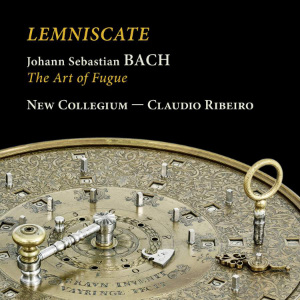
Johann Sebastian Bach (1685-1750)
Lemniscate
The Art of Fugue BWV1080 (?1740-1746)New Collegium/Claudio Ribeiro
rec. 2022, Westvest90, Schiedam, the Netherlands.
RAMÉE RAM2208 [73]
Arrangements of Bach’s The Art of Fugue can be found from solo to symphony orchestra, and its enigmatic four-stave score with no instrumentation indicated is an open invitation to all kinds of interpretation in terms of timbre. Early music specialist ensemble New Collegium has already recorded Telemann (review), C.P.E Bach (review) and others for the Ramée label, and with solid foundations in research and performance practice from in and around the Royal Conservatoire in The Hague this is always going to be a source worth hearing.
Alongside its contrapuntal magnificence, these musicians also see the movements in The Art of Fugue as “movingly lyrical, and deserve to be enjoyed for their pure beauty, just as one enjoys the rhythms and sounds in the words of a poem, regardless of form and sometimes even meaning.” The New Collegium ensemble uses the last version of J.S. Bach’s manuscript for this recording, “bringing to the fore both the cerebral brilliance as well as the emotive intensity of this iconic masterpiece, allowing it to be both light and profound.”
There is indeed a good deal of variety in this performance. The added winds and trombones add marvellous colour, with the brass providing hints of Giovanni Gabrielli here and there. This ensemble is not afraid to project specific ideas onto certain movements. The spicy rhythms and orchestration of Contrapunctus 6 takes us firmly into the French theatre with its “Ouverture” subtitle, and muted strings for the following Contrapunctus 7 “Memoria” has a nice antique plangency that might suit a wood-panelled candle-lit Elizabethan nocturne. If anything this recording might have gone even further in this direction, but with such quality playing this is only a marginal observation. Not everything is orchestrated, and Claudio Ribeiro’s crisp harpsichord playing is a central feature. There are movements with strings alone as well as strings with harpsichord, and the contrasts of texture with winds arrive with a sense of natural flow.
With its imaginative instrumentation and nicely balanced recording set in a nicely resonant church acoustic this is a BWV 1080 with great appeal and much to recommend it. There is no consolatory chorale to round off the programme but this is a deliberate choice, with those final unfinished notes in the last three-part fugue subtitled “Ewige Wiederkunft” and described in the booklet as a circulating figure “like a lemniscate, perhaps suggesting that the art of counterpoint is infinite.”
Dominy Clements
Help us financially by purchasing from



Contents
Contrapunctus, BWV 1080/1
Contrapunctus, BWV 1080/3
Contrapunctus, BWV 10080/2
Contrapunctus, BWV 1080/5
Contrapunctus, BWV 1080/9
Contrapunctus, BWV 1080/10a
Contrapunctus, BWV 1080/6
Contrapunctus, BWV 1080/7
Contrapunctus, BWV 1080/15
Contrapunctus, BWV 1080/8
Contrapunctus, BWV 1080/11
Canon, BWV deest
Contrapunctus, BWV 1080/12,1
Contrapunctus, BWV 1080/12,2
Contrapunctus, BWV 1080/13,1
Contrapunctus, BWV 1080/13,2
Canon al roverscio et per augmentationem, BWV 1080/14
Fuga, BWV 1080/18,1
Fuga, BWV 1080/18,2
Fuga, BWV 1080/19
New Collegium: Inês d’Avena (recorder); Sara DeCorso (violin); Tomoe Badiarova and Barbara Konrad (viola); Rebecca Rosen (cello); Anna Lachegyi (viola da gamba); Tami Krausz (traverso); Daniel Lanthier (oboe & oboe da caccia); Jamie Savan (cornetto); Matthijs van der Moolen (alto & tenor trombone); Joost Swinkels (tenor & bass trombone); Wouter Verschuren (bassoon); Claudio Ribeiro (harpsichord / direction)


















